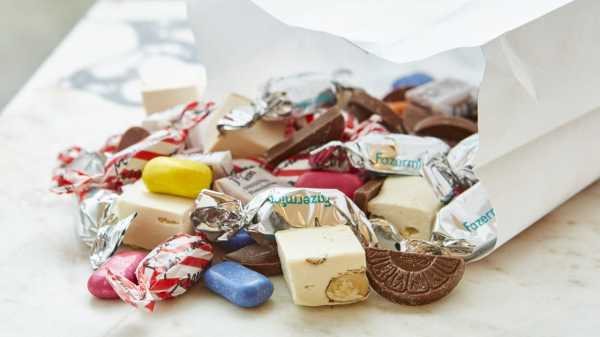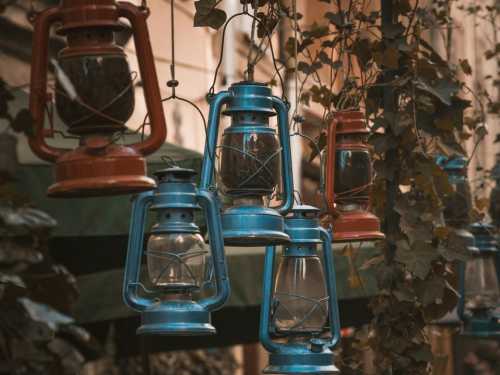
At New York’s newest Swedish candy store, Bon Bon, on the Lower East Side—there’s another one, in the West Village, called Sockerbit, which means “sugar lump”—one of the scoop-your-own bins contains a confection labelled Socialcandy. Socialcandy are slightly sticky gummies, in opaque pastel shades ranging from yellow to pink to seafoam green, with vaguely tropical flavors (tutti frutti, you might say), and different shapes, most of which take the form of a word, acronym, or symbol of the Internet age. There’s a LOL, a YOLO, a hashtag, a thumb’s-up sign that looks like the one on Facebook. There’s an O.M.G., a SELFIE, an @, and a <3. The only outlier is a squishy stack of words that I had to squint at to make out: CANDY PEOPLE. The longer I looked at it, the stronger my desire was to eat it. In Internet parlance, “it me”—which is to say, I am a Candy Person.
Make no mistake—my parents didn’t raise me this way. In fact, as a child, my access to sweets was so limited that I made my Halloween hauls last for months. But ultimately, the restriction seems to have backfired. As an adult, when I am supposed to seek only the refined and bitter pleasures of eighty-five-per-cent dark chocolate, I have regressed, craving only the milkiest of milk. When I am supposed to turn my nose up at the artificial colors, flavors, textures, and whimsical shapes of gummies, I take more delight in them than ever. As I write this, I am chewing happily on a spongy little number in the shape of a miniature sunny-side-up egg, plucked from a large sack of treats I gathered the other day at Bon Bon. It tastes basically of nothing but gives me great shivers of pleasure as I move it between my teeth. And have you ever seen anything so cute?
Nordic countries, in general, are crazy for candy. On a trip to Iceland a few years ago, I was amazed by the wide selection of sweets sold by the pound at even the most average-looking gas stations. But if any one particular country knows from candy, it’s Sweden, whose residents, according to a study by the Swedish Board of Agriculture, eat more per year per capita—more than thirty pounds per person each—than the citizens of any other nation. In Sweden, every Saturday is effectively a national holiday, called lördagsgodis, which means “Saturday candy.” Every corner store has a wall of pick-and-mix bins. The history of how this tradition came to be is surprisingly dark: in the nineteen-forties, in conjunction with several candy corporations, the Swedish government performed tests on patients in a mental institution to explore the hazards of consuming sweets. When it was determined that too many would make your teeth rot, lördagsgodis was born—Swedish citizens were urged to have as much candy as they liked, as long as they limited their consumption to one day a week.
And so it became a crucial, and deeply beloved aspect of Swedish culture—and not just for children. A friend of a friend named Danielle, who is married to a Swedish man, marvelled that her “thin, thirtysomething” sister-in-law’s nightly routine, at her home in Copenhagen, involves sneaking to the store on the ground floor of her apartment building after she’s put her kids to bed, gathering a large bag of pick-and-mix candy, then plopping in front of the TV to eat it. “It struck me as totally shameless behavior,” Danielle said. “The kind of thing you’re not supposed to do after the age of twelve." Both Bon Bon and Sockerbit seem designed to appeal as much to adults as to kids. Sockerbit’s Web site makes eating candy sound like an essential element of what is these days referred to as a “self-care”: “Sometimes we feel like something sour and sweet at the same time … and sometimes we need chocolate but mixed with some fruity surprises… It all depends on how we feel, our mood, the weather…. You could say that each person’s candy bag reflects the state of mind of that person.” Danielle posits that Swedes love candy because the sun barely rises in the winter.“It’s dark and depressing and they need sugar,” she said. “Same reason they drink more coffee per capita than most other places in the world.”

Inside New York’s newest Swedish candy store, Bon Bon, on the Lower East Side.
Photograph by Selim Adira
It’s springtime in New York, but the winter was a long one, and certainly depressing, if not particularly for lack of sunlight. At Bon Bon, one recent afternoon, I was greeted with joy by one of the three Swedish owners, Robert Persson, who wore a pair of John Lennon-esque eyeglasses and had his shoulder-length red hair pulled into a low bun. Could he offer me a “freshly harvested strawberry?” he wanted to know, as he used tongs to place a red-and-green translucent gummy, in the shape of the fruit though flat and twice as big, into my palm. Swedish candy is generally “healthier” than American candy, he explained, because it doesn’t contain corn syrup, gluten, or trans fats. Healthy was not the first word that came to mind as I chewed; it tasted of artificial strawberry flavor, as opposed to strawberries themselves, just as the yellow half of a two-color, pill-shaped banana-and-caramel “bub”— “of the marshmallow family”—tasted, quite pleasingly, of artificial banana. The flavor of a skull-shaped gummy, on the other hand, Pepto-Bismol-pink and coated in sour sugar crystals, was shockingly reminiscent of a real strawberry, specifically an alpine variety, according to Persson. I stocked up on those, plus some gummies in the shape of vampire teeth, gummy Coke bottles; a scoopful of delicate little marshmallows that looked like pink-capped mushrooms; and a small selection of what we in America know as Swedish fish but in Sweden are called pastellfiskar, or pale fish—because, when in Rome.
The pastellfiskar come in red, yellow, and orange, but also in black—the latter made of salmiak, or salty licorice. If there’s one way in which my palate has progressed as I’ve aged, it’s that I’ve developed a love of licorice, which I used to abhor. Persson offered me a wrapped candy called Dumle, which he described as “a good gateway for people who don’t think they like licorice.” It was a chocolate-coated caramel with a distinct but subtle anise aftertaste. It was delicious, but not strong enough. In Scandinavia, licorice is taken to extremes, often made so salty (with the addition of ammonium chloride) that it can make your tongue pucker. (“Someone told me it feels like an oil spill in your mouth,” Danielle’s Swedish husband recalled, with glee.) I’ve tried it, and even enjoyed it, in a certain state of mind, but I was secretly relieved, when Persson pointed to a bin of the saltiest kind they had, to see that it was almost empty. I plucked up, instead, a plain old sweet licorice pipe, and let it dangle from the corner of my lip as I chewed, pulling it up with my teeth until it disappeared.
Sourse: newyorker.com






